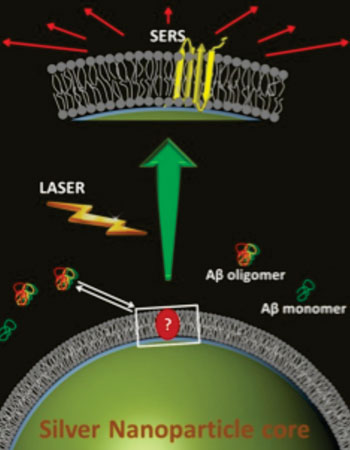Nanoparticle-Augmented Spectroscopy Reveals Structure of Alzheimer's Disease Peptide
By LabMedica International staff writers
Posted on 07 Sep 2015
The use of lipid bilayer-encapsulated silver nanoparticles to increase the sensitivity of a Raman spectroscopy technique allowed researchers to determine the structure of Alzheimer's disease-related membrane-attached oligomers of amyloid-beta40 (Abeta40) peptide.Posted on 07 Sep 2015
Raman spectroscopy exploits the inelastic scattering (so-called “Raman” scattering) phenomena to detect spectral signatures of important disease progression biomarkers, including lipids, proteins, and amino acids. In a novel modification of the Raman technique, investigators at the Tata Institute of Fundamental Research (Mumbai, India) and the University of Toronto (Canada) introduced a surface enhanced Raman spectroscopy technique that could determine the conformation of membrane-bound proteins, at low micromolar concentrations, and also in the presence of a substantial membrane-free fraction. Unlike conventional surface enhanced Raman spectroscopy, this approach did not require immobilization of molecules, as it used spontaneous binding of proteins to lipid bilayer-encapsulated silver nanoparticles.

Image: Toxic Alzheimer\'s amyloid beta molecules landing on a fake cell membrane, wrapped around a silver nanoparticle. A laser, with help from the silver particle, lights up the molecule to reveal its structure (Photo courtesy of Dr. Debanjan Bhowmik, Tata Institute of Fundamental Research).
The investigators applied this technique to probe the structure of membrane-attached oligomers of amyloid-beta40 (Abeta40), whose conformation is needed to explain certain aspects of Alzheimer’s disease.
They reported in the August 25, 2015, online edition of the journal ACS Nano that isotope-shifts in the Raman spectra helped them to obtain secondary structure information at the level of individual residues. Results showed the presence of a beta-turn, flanked by two beta-sheet regions. The investigators then used solid-state NMR data to confirm the presence of the beta-sheets in these regions. In the membrane-attached oligomer, they found a strongly contrasting and near-orthogonal orientation of the backbone H-bonds compared to what is found in the mature, less-toxic Abeta fibrils.
Contributing author Dr. Gilbert Walker, professor of chemistry at the University of Toronto, said, "While the amyloid beta got fooled by the fat layer-encased silver nanoparticles that mimicked the outer membranes of living cells and stuck to the membrane, the silver inside enhanced the signal to a measurable level and acted as a light beacon to reveal the peptide signature."
"Everybody wants to make the key to solve Alzheimer's disease, but we do not know what the lock looks like. We now have a glimpse of something which could be the lock. May be it is still not the real thing, but as of now, this is our best bet," said senior author Dr. Sudipta Maiti, professor of chemical sciences at the Tata Institute of Fundamental Research.
Related Links:
Tata Institute of Fundamental Research
University of Toronto













